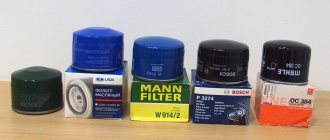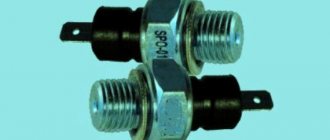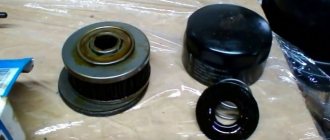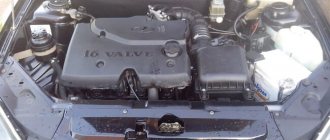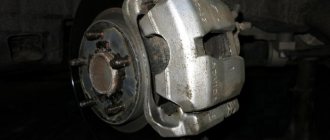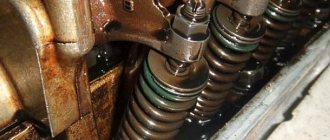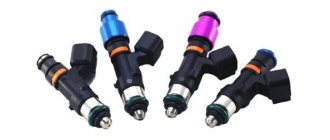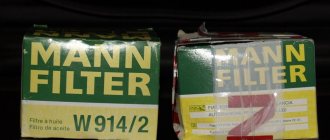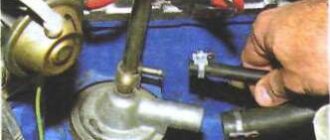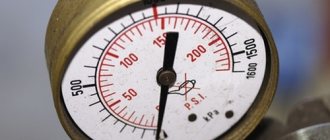The main reasons for this problem
For experienced motorists with extensive driving experience, a situation where oil has been squeezed out through the oil filter may be due to the following:
- serious malfunction of the valve itself;
- large discrepancy between the viscosity of the lubricant and the characteristics of the power unit;
- weak fixation of the filter itself on the surface of the fitting;
- severe contamination of the filter surface, which made it difficult for the lubricant to pass through the filter paper;
- use of low-quality polymer-type sealant.
It should be remembered that the above reasons cannot arise on their own, but are the result of serious mistakes made during the operation of the car.
Why is oil leaking from under the oil filter?
Let's start with the fact that the list of reasons why oil is squeezed out in the oil filter area is quite wide. Most often, the culprit is the owner himself, who has not changed the oil filter for a long time.
- Under certain conditions, contamination of the oil filter can lead to the fact that the throughput is greatly reduced; lubricant practically does not pass through the filter media. At the same time, to protect the engine from oil starvation, the filter design usually has a special bypass valve (allows the oil to bypass the filter element), but the possibility of failures during its operation cannot be ruled out.
We also recommend reading the article about
how to choose the best oil filter for your engine
. From this article you will learn about the types and types of oil filters, as well as which oil filter is best to purchase, taking into account certain features.
If the cleanliness and “freshness” of the filter is beyond doubt, then errors could have been made during its installation. If a leak appears immediately after replacing the filter, it is quite possible that the filter itself is not tightened enough or the housing is not tightened (in the case of a collapsible design). This indicates the need for tightening. This procedure is carried out by hand or using a special plastic key puller.
A mandatory condition can be considered the absence of force when tightening, since overtightening leads to ruptures of the sealing gum and deformation of the o-ring. If this happens, the filter must be replaced with a new one or the problem must be solved by replacing the damaged seal.
Let us add that very often during installation, car owners and mechanics forget to lubricate the above rubber sealing ring on the oil filter housing with engine oil. This leads to the fact that after tightening the filter, it may not fit tightly; the seal may be deformed or placed skewed.
In any case, the oil filter must be removed, the integrity of the seal must be checked, the rubber band must be lubricated, and the filter element must be installed in place, taking into account the features of its installation. You should also remember that a defective oil filter may come across on sale. In such a situation, the housing itself may be defective, on which there are cracks, the seal may be made of low-quality rubber, the valve in the filter does not work, etc.
- High engine oil pressure is the second most common cause of oil leaks in the oil filter area. An increase in pressure in the lubrication system can occur for various reasons, ranging from significant thickening of the lubricant combined with an excess of oil level to certain mechanical failures.
Let's start with the bypass valve. This valve is necessary to relieve oil pressure if the specified value is exceeded. The valve can be located in the area of the filter holder, as well as on the oil pump itself (depending on the design features). To check, you need to get to the valve and evaluate its performance.
Stuck in the closed position causes the element to not work. In this case, the device must be cleaned and washed. Gasoline, carburetor cleaner, kerosene, etc. are suitable for cleaning. Note that, as practice shows, it is better to replace a jammed valve if possible, especially considering its relatively affordable price.
- Another reason for leaks associated with the oil filter is a problem with the threads on the fitting where the filter is screwed on. If the threads are stripped or damaged, then the filter housing cannot be properly tightened during installation, resulting in oil being squeezed out. In such a situation, it is necessary to change the fitting or cut a new thread.
It is also worth highlighting that if the oil is chosen incorrectly, that is, it becomes too liquid or viscous, then leaks often occur in the area of gaskets and seals. The oil filter is no exception. The lubricant should be selected in accordance with the requirements of the vehicle manufacturer, and also take into account the features and operating conditions.
Note that if the driver constantly uses the same type of oil, the filter is not dirty, no significant changes in weather conditions have occurred, and there are no obvious engine malfunctions, then the fact of pouring counterfeit motor oil into the engine may occur. It turns out that low-quality lubricant simply does not have the declared properties, resulting in leaks.
The solution in this situation is obvious - immediate replacement of the filter and lubricant is necessary, and additional flushing of the engine lubrication system may also be necessary. Finally, we add that blockage of the pipes of the engine crankcase ventilation system leads to the fact that gases accumulate inside the internal combustion engine, the pressure inside the engine increases and the oil is squeezed out through the gaskets and seals. The specified crankcase ventilation system must be checked during the diagnostic process, and also periodically cleaned for preventive purposes.
Oil filter leaking: reasons
The fact that the oil filter is leaking can be seen by drops of oil on the asphalt, under the car engine.
Oil is squeezed out by high pressure, so many drivers, in order to quickly get rid of the problem, simply tighten the filter housing.
However, this can only eliminate the external manifestation of the problem, but to really get rid of it, you need to delve into the causes. Watch the video “Oil filter gasket squeezed out” below
There are several possible reasons for a leaking oil filter:
- The oil does not have the viscosity required for this engine, i.e. the oil is not selected correctly;
- The oil filter housing is too soft, poor quality;
- The filter housing was installed poorly on the seat - the connection was overtightened, as a result of which the rubber band was deformed and the seal was broken;
- The rubber seal on the oil filter is broken;
- The pressure reducing or bypass valve has failed.
When determining the cause of an oil leak, you need to take into account the quality of materials and weather conditions. Let's take a closer look at the reasons that lead to oil being squeezed out of the filter.
Driving in cold weather at high speeds
Firstly, is there frost or not? At low temperatures, the crankshaft seals harden, and when thickened mineral oil flows under pressure through the bypass valve (especially if there is still a filter with a rubber petal valve), the crankshaft seals are damaged. It will be cheaper to replace the oil filter and oil first than to change the crankshaft seals later.
More suitable for frost:
1) oil filter with spring bypass valve; when installing such a filter, you need to make sure that the spring valve does not jam (sometimes a leak occurs for this reason too);
2) oil with a viscosity of 0W20 (do-it-yourself engine oil change).
If the oil filter is designed for synthetic oil with low viscosity, then the number of inlet holes in it is smaller, and the holes themselves are smaller. Such an oil filter leaks: it cannot pass cold high-viscosity mineral oil well, the filter housing swells due to high pressure, and its gasket is squeezed out.
Using Oil Additives
Oil also flows due to the addition of various additives to it, which supposedly quickly restore the rubbing surfaces of parts. In reality, all these additives eventually clog the filter and oil begins to leak through the seal.
Flushing the lubrication system with kerosene, gasoline or acetone
Such traditional methods, when the listed liquids are added to the oil and then the lubrication system is washed with this mixture, have a detrimental effect on its condition. Harmful sediments are dissolved in the drain channels and in the engine sump, rather than being removed.
Then, when the engine is idling, the remaining flushing mixture is squeezed out through the crankshaft seals and the housing seal. In addition, all gaskets in the lubrication system become deformed and swell.
Thus, it is absolutely impossible to save on the purchase of special liquids for flushing the lubrication system.
Using high viscosity motor oil
These oils are advertised as guaranteeing optimal pressure for engines with considerable mileage and wear. For hot weather, such small ones are really the best option. But when it gets cold, the oil filter leaks, as approximately the same mechanism as described in the previous paragraph works.
No oil system flushing
If the lubrication system is not flushed with a special product, this also leads to oil leakage from the oil filter (details: how to flush the oil system).
If you fill in new engine oil without first flushing the lubrication system, then you need to install an inexpensive oil filter so that all the dirt remaining in the system settles on it when the car travels 100-150 km. After this, you can install a new high-quality filter.
However, this option is suitable provided that the oil used is of high quality and contains detergent additives.
Constant topping up, not changing oil
As a rule, owners of old cars are guilty of this. The oil filter leaks when a large volume of gasoline and water gets into the engine pan, and the leak appears even in slight frost.
Violation of the geometry of the oil filter location
This happens when the oil filter was removed with great effort. Or the filter housing has suffered impacts. What happens: the central fitting of the filter is displaced, as a result, the tightness of the seal is broken, and the oil filter leaks.
Poor quality oil filter
Low-quality filters are usually fakes. They are bad because the bypass valve, filter layer and seal in them are made of low quality materials. When oil begins to be squeezed out of such a filter, its body, cover and valve rubber are also squeezed out and deformed.
How to distinguish a fake oil filter from an original one?
If you blow into the filter inlet and the valve petal does not open, it means the filter is real, not a fake. If the valve petal opens easily when you exhale, then there is a fake filter.
The ribs of the filter accordion must be smooth and evenly colored, the inner surface of the central bushing must be smooth, without metal burrs - this is characteristic of the original oil filter.
In the original filter, the height of the rubber seal ring above the lid should not exceed 0.8 mm, and the material should be elastic and hard.
Reducing valve sticks
In oil pumps of VAZ cars, it often happens that the pressure relief valve gets stuck: either dirt has gotten into the oil, or the engine has overheated. If the oil filter is leaking again, you need to take this into account, clean the oil pump and check its operation.
Video: Oil filter gasket squeezed out
If the video doesn't show, refresh the page or click here
Main causes and ways to eliminate them
There can be many reasons that cause oil leakage, there can be several main ones, let’s look at them:
| Malfunction | Remedy |
| During installation, they forgot to lubricate the rubber of the oil filter barrier and it became skewed or deformed during tightening | Remove the barrier, lubricate the rubber and reinstall |
| After replacement, the oil filter was not tightened | Tighten until it stops, but only with your hands without using tools. |
| Leaking due to the oil filter being overtightened during replacement | Remove the barrier; if the elastic band is deformed, replace it and install a new one without using excessive force |
| Damage to the sealing surface of the barrier (the ebb surface on the motor in contact with the rubber band) | Replace barrier |
| High lubricant pressure in the engine | There are many reasons, the oil or barrier may need to be changed |
| Unheated car. On old-style models, oil pumps are installed in which there is no oil pressure relief valve, in case of excessive increase, and the external auto-valve is either not installed or is faulty | Warm up the car, inspect the pump and valves |
| Dirty filter element | Replace the barrier. When changing the filter, tighten it only by hand. Just tighten it well. Because if you tighten it with a wrench, there is a risk of squeezing out the rubber and causing a leak again. |
If everything is in order with the lubricant and filter, but oil is squeezed out through the oil filter again, then perhaps the pump itself is faulty, namely the pressure reducing valve.
Extruded lubricant mixture
Why oil squeezes out from under the filter: reasons, photo and video review
The main reason why oil is squeezed out from under the filter, as a rule, is starting a cold engine. At this moment, the consistency of the lubricant is so thick that it simply does not have time to pass through the oil filter.
Oil leak
This usually occurs on older vehicles that have an oil pump that does not have a bypass valve. This certainly cannot happen with new cars, except perhaps if it is not tightened well enough, and then it presses oil from under the filter.
Main causes and ways to eliminate them
There can be many reasons that cause oil leakage, there can be several main ones, let’s look at them:
If everything is in order with the lubricant and filter, but oil is squeezed out through the oil filter again, then perhaps the pump itself is faulty, namely the pressure reducing valve.
Extruded lubricant mixture
Fixing the problem
The valve can be removed without removing the pump itself.
What will you need?
Stages
- Remove the timing belt cover.
- Unscrew the auto valve plug.
- We remove the spring.
- We take out the valve and check it for scratches and mechanical damage.
- Check the condition of the spring itself.
There should be no kinks on it, and the height should be 44.72 millimeters, otherwise replace it. - Review of the Geely MK oil filter
- Tips for selecting an oil filter
- Engine oil: how much to pour and what does it depend on?
We have listed almost all the possible reasons why lubricant is leaking; if even after this the problem is not resolved, then you should seek help from professionals at a service station.
It is possible that they will be able to find something else and fix the leak.
Video “Grease leaked”
This video shows why a lubricant leak occurred and what can be done to fix it. In this case, the rubber band was distorted due to careless actions of the mechanic at the service station.
and reviews
And if you put a closed electric hotplate on to heat the engine, then it may be that the oil overheated and something got under the valve and it jammed, and squeezed the oil out from under the filter.
Ivan Ivanovich Baranov
Experience working at a service station:
View all answers
Avtozam.com is your assistant in car repair and maintenance
Your use of this website constitutes your agreement that your use is at your own risk.
https://avtozam.com/dvigatel/motor-maslo/podtekaet-maslofiltr/
While operating a car, car owners often encounter trouble in the form of a leak from the oil filter.
A puddle that forms under a car is an unpleasant situation and exciting for the driver. An oil leak in the filter area does not bode well, as it hides a number of unfavorable factors.
This problem can occur both in a used car and in almost new internal combustion engines.
Some experienced drivers solve this issue by tightening the filter housing, as they believe that a similar problem arises as a result of:
- valve malfunction;
- inconsistencies in the viscosity of the lubricating fluid;
- low-quality polymer seal.
The reason may also be poor fixation of the filtrate on the fitting or its contamination.
The main mistake made by drivers, which results in oil being squeezed out through the oil filter, is considered to be a cold start of the engine at high speeds. This is especially common in used cars. This is absolutely not necessary, since oil compositions, especially those of mineral origin, thicken in the cold and become like jelly.
The pump produces high pressure at higher speeds and can force lubricant through any leaky areas. In addition, in this mode, damage to the seals on the crankshaft is possible, and this is fraught with repairs and unplanned expenses.
Renumax is a revolutionary scratch remover! Don't waste money on repainting! Now you can remove any scratch from the body of your car in just 5 seconds.
Innaqua system – protect your car for 12 months with the Innaqua system nano-product!
If you often have to deal with frost, it is recommended to change the previous composition to oil with a viscosity of 0w20 and a filter with a spring mechanism.
Another well-known mistake that causes oil to be squeezed out from under the oil filter is the use of fast-acting substances that can quickly restore contact between rubbing parts. It is worth considering that the use of components is considered by the system as garbage and it will settle on the filtrate, interfering with the movement of the oil flow and, as a result, the lubricant is squeezed out through the seals.
There are several other important situations when a squeezing effect through the oil filtrate may occur:
The fuel and lubricants market is already overcrowded with low-quality products. Therefore, it’s easy to fall for the bait of unscrupulous sellers. There are several distinctive signs by which you can determine whether the material is fake or not.
The first parameter of a low-quality oil filter is the packaging geometry. If the case is deformed, then this is one of the signs of counterfeit. You can check the quality properties of the filtrate in another simple way, namely by blowing into the inlet holes. If the product is of high quality, then the petal should not open, but in a fake it’s the opposite.
It is worth paying attention to the polymer sealing ring and monitoring the condition of the filter paper. If a paper accordion has unevenness or different colors, then it is a fake. As for the polymer ring, its height should not exceed 0.8 mm above the level of the lid.
https://prem-motors.ru/pochemu-techet-maslo-iz-pod-maslyanogo-filtra/
The reduction valve is working properly.
If the problem was a clogged channel, the filter would be squeezed out at every start.
Please help me figure out where to look for the problem.
I really don’t want to repair the consequences, but leave the problem itself (
Most likely the quality of the oil. Too thick + fake. This question should have been asked immediately after the incident with the filter.
and the pump has a pressure reducing valve, it is not rusty from excellent oil)))
In the second case, the following happened: first, the filter gasket was squeezed out, and through it all the oil was expelled from the sump - that’s why the crankcase turned out to be dry. But, I think you knew this without me.
A very interesting case indeed - and would really appreciate it if you could get to the root of all this.
I can’t believe at all that the quality of both filters and the oil is poor - something obviously got into the oil line, and right behind the filter. The valve has nothing to do with it, because... it has such a design that no rust can immobilize it.
This is a joke about rust, but it’s completely jammed. after all, the whole thing took place in severe frost. people and what current comes in at this time. one hundred percent valve, as said
The oil did not find a place to go and naturally the filter is a weak point. This case is about what kind of oil to choose, so that you do less experimentation.
I will search 100%, even if the entire engine is thrown away.
I have already received approximate search guidelines.
The following question arose in my head while the car is in the box and the master will only be there on the fourth.
Could the fact that the engine stopped while moving (80 km/h) also damage the gearbox?
Judge for yourself what can clog the channel, there must be crap in there, this is the first and stupid assumption, even if it was clogged tightly, then the pressure should have been released through something that is right up to the entire oil supply system, right at the pump. but not after the filter
It looks like the picture is like this: the channel is clogged. The excess pressure should have been relieved through the pressure relief valve, but it doesn’t work, so it presses through the oil filter.
The only thing I don’t understand is the frequency. In the first case there was no frost, but in the second it occurred only two months later.
The pressure reducing valve is faulty, I had this happen several times on the 099, I don’t know what the motorist treated and how, but everything returned to normal.
Well, it became somehow sideways or skewed somehow, not much, but this is no longer the point, dirt is also not a fact, for example, the valve is adjusted to 4 atm. you gave coke 180 km per hour. engine speed, mother, don’t worry, of course the pressure is terrible, but the valve is not firsteen. That's where it came from the weak link. smoked it.
This is my first year driving a maximum speed of 90))) so what are you talking about Vovan_mail
and you can’t get the gas up to 6000 rpm either, and I know you are newbies, 90, something slipped by and you didn’t even determine what kind of car disappeared on the horizon
In the second case, the engine was completely warmed up to a temperature of around 100 degrees - what kind of frost are we talking about? In comparison with the first case, the problem remains => the conclusion suggests itself that nothing depends on temperature.
What is the probability that the oil was substandard both times and the pressure reducing valves both times?
What this means is that there is high pressure in the system.
This does not mean that the temperature is high, even at zero degrees at start the pressure will be higher.
The valve in the pump does not work.
Yes, most likely you are right.
In the first case, a cheaper filter saved the engine. (having expelled 4 liters of oil in a couple of seconds of work)
In the second, a better one killed it))) by expelling the oil while driving, and the leak started while still warming up (I later found a small puddle in the evening), but it was not very intense and the oil bottle failed.
But could I, with the engine jammed while driving (80 km/h), also break the gearbox?
This is confirmation of my assumptions
You should have immediately sounded the alarm when the filter swelled. Otherwise, this defect simply cannot be caught.
But could the box get caught or not?
It’s unlikely, but on wet asphalt it could easily get caught in a ditch.
So, how did the engine blocking process happen for you? With wheel locking?
It seems yes, because... I braked sharply and swayed a little to the side. But fortunately there is no ice.
The reduction valve is working properly.
If the problem was a clogged channel, the filter would be squeezed out at every start.
Please help me figure out where to look for the problem.
and how did you check the valve, it can sometimes jam
How else can I check it?
Or it should be replaced immediately.
The valve is only clean by eye, without burrs. There are no traces of anything being hit.
https://ffclub.ru/topic/265240/
Why and why engine oil leaks from under the oil filter after replacing it
The filter element is a removable component. The housing filter is mounted by screwing onto the threaded end of the cylinder block. It is twisted all the way so that the end rubber is pressed tightly against the mating surface on the engine. Recommendations for the limiting torque are contained on the side surface of the oil filter. The value is indicated in the form of a graduated rotation pictogram, which must be carried out after the end of the easy stroke.
Incorrect installation of the filter element
The main reason for oil leakage from under the oil filter on a new engine is failure to comply with the torque limit requirements. The lubricant is pressed both when under-tightening and when over-tightening. In the first case, the rubber simply does not fulfill the task of sealing, since it is not clamped between the ends; in the second, its shape is deformed or the rubber product completely breaks.
Initially, they start from a less critical point of view: it is assumed that the filter element is not tightened enough. A component that is clamped to capacity will not rotate, but a component that is not tightened will make an extra 1/2-3/4 of a turn, which is sometimes quite enough.
Among the icons on the side panel of the filter, another one is important; it requires you to lubricate its rubber ring with oil before installing the cleaning module. New or old - it doesn’t matter, the fact that the oil composition is located on the outer end of the seal is significant:
- The lubricant prevents the rubber product from cracking when tightened tightly.
- The viscous layer promotes a tight fit of the ring to the mating end on the cylinder block.
- A layer of emulsion between the rubber and metal prevents the ring from sticking to the engine body.
Low quality filter
Poor quality paper or a defective bypass valve in the purifier body creates noticeable resistance to the flow of oil, and it begins to look for alternative ways to exit the defective component. General advice is to ignore products from little-known manufacturers that have an affordable price, and beware of counterfeits of well-known brands.
Exceeding the recommended amount of lubricant in the engine crankcase
At a level above MAX, it is clear why oil leaks from under the engine oil filter. Due to the increase in pressure, even a small overflow of oil into the engine leads to squeezing it out through all kinds of oil seals. There is only one recommendation - to bleed off the excess volume as soon as possible.
Unsuitable oil
The optimal viscosity of the oil emulsion is calculated based on many factors, the main ones being the clearances in the cylinder-piston group and the ambient temperature. What the engineers calculated is displayed in the operating book in the form of a list of recommended viscosity characteristics of the composition.
Deviation in favor of unspecified viscous or liquid categories leads to leakage at the points where the sealing elements are attached. Choosing without taking into account the average winter temperature is also illiterate - in the cold the lubricant thickens and may not pass through the filter. In the event of a strong difference in summer and winter temperatures, it is useful to know how to heat the oil in the crankcase of a car engine.
Complying with the instructions is a surefire way to properly operate a car, but no one is safe from counterfeits. Fake lubricant can be squeezed out and the only way to identify the cause is to understand the differences between the canisters of the original and the “basement” product.
If the oil filter leaks after replacement
Sometimes it happens that the leak from under the oil filter continues even after replacing the filter. This may be due to:
- the oil filter has not been tightened: it is necessary (only with your hands!) to tighten the filter until it stops, then the oil flow from under the oil filter cap will stop;
- When installing the filter, the rubber band of the filter oil barrier was not lubricated, and when screwed in, it became deformed or skewed - you need to remove the barrier, lubricate the rubber band and reinstall it;
- while replacing the filter, the oil filter was overtightened - you will need to remove the barrier, replace the deformed rubber band and install it again without unnecessary effort;
- the wrong filter was chosen for replacement (for example, oil leakage from under the Peugeot oil filter often occurs if a non-original filter is installed) - in order to prevent oil leakage from under the Peugeot oil filter, you should replace the filter with an original one or its high-quality analogue.
You can replace the oil filter in almost any car yourself. If you succeed the first time, then great. Otherwise, it is better to contact a service center so as not to waste extra time and spoil the new filters. Experienced specialists will advise which filter is needed for your car and install it correctly (or fix the problem without replacing the filter).
Consequences of breakdown
There are a number of negative consequences of lubricant leaking from under the filter element.
- Starvation of mechanisms due to decreased fluid levels.
- Alternator belt slipping.
- Short circuit of electrical circuits due to liquid ingress.
Important! It is not recommended to start a breakdown. Operating a vehicle can only make the situation worse. If there is excess pressure in the system, a further increase may cause the shaft seals to be squeezed out and substances to penetrate into the fuel combustion chamber.
Consequences of oil leakage
Oil lubricant for a car is like blood for a biological organism, because it is the lubricant that ensures the performance of the engine. Based on this fact, you should never turn a blind eye to oil leakage, otherwise it will lead to engine blockages, failure, and even fire. Another dangerous consequence of an oil leak lies in possible damage to the engine due to the absence or lack of lubrication during operation. In addition, the clutch may slip for the same reason.
Solving such problems on your own is often either difficult or completely impossible, and then it would be safer to contact a car service center.
How to eliminate lubricant leakage through the filter
If the oil has been squeezed out through the oil filter and the cause has already been found, then you need to start eliminating the leak. To carry out repair work, you need to prepare a set of keys and some rags.
The entire repair process consists of the following activities:
- using keys, remove the timing belt cover;
- the auto valve plug is unscrewed;
- the spring is carefully removed;
- the valve is removed and checked for scoring or other types of mechanical damage;
Particular attention must be paid to the technical condition of the spring. There should be no kinks on its surface. It is very important that the spring height is 44.7 mm; if there is a strong deviation from the optimal height, then it is better to replace the spring.
How to fix a leak from the oil filter
So, in most cases, it is enough to fill in high-quality oil, taking into account the manufacturer’s recommendations and seasonality, change or install the oil filter correctly.
If you have basic skills, you can easily cope with cleaning the crankcase ventilation system. This means that in most cases, almost every driver in a garage can fix an oil leak with his own hands.
As for more complex faults, these include a failed pressure relief valve and a damaged thread on the fitting for securing the oil filter. In practice, a problem with the valve is more common, so let's specifically focus on checking it.
The main task is to check the valve spring, which is located under the plug. It is she who is responsible for the operation of the device; the overall performance will depend on the state of the spring. The specified spring must be removed from its socket for inspection. The presence of burrs, creases, bends and other defects is not allowed. Also, the spring should be tight, not loose.
If the spring can be easily stretched by hand, this indicates a weakening of this element. Also, the overall length of the spring should not be increased, which would indicate stretching. A decrease in length is an indication that part of the spring has broken off. In such a situation, debris must also be removed from the valve seat. Detection of any defects in the spring is a reason to replace it.
Is it worth paying extra for a branded filter?
The instructions for replacing the oil filter in your car's manual provide for the use of original filters recommended by the manufacturer. The advantages of the original are a guarantee, full compatibility and quality of workmanship. There is only one minus - the price. The non-original has one main advantage - low cost. There are a lot of minuses. These are low-quality materials, rough processing, and sizes that do not match the original. Often, having saved on a filter, you can lose a lot of money on repairing an engine ruined by using a low-quality filter, which may not clean the oil at all. It is better to choose a filter from well-known brands such as Bosch, Filtron, or Goodwill.
How to fix the problem
Elimination of lubricant leaks from under the filter is carried out after determining the cause of the breakdown. The diagnostic procedure is performed using the method of exclusion.
- Disassemble and clean the pressure relief valve.
- If a leak appears after replacing the internal combustion engine lubricant, it is necessary to tighten the filter.
- If a leak is observed further, the rubber seal under the element is replaced. The ring is pre-lubricated to prevent rupture.
- If liquid continues to ooze, it is necessary to replace the structure with a new one.
If a blockage in the pressure line is detected, the motor must be disassembled and thoroughly cleaned using professional equipment. The operation is performed only by qualified specialists.
Note! Some engine models are not equipped with a pressure relief valve.
It is also necessary to take into account that it is recommended to install original spare parts during repairs. For example, Renault car models may leak if non-original filtrate is used.
Causes of failure
Why is oil leaking from under the oil filter? The main causes of the malfunction are the following factors.
- Starting the power plant in severe frost. Oil thickens at low temperatures. This prevents lubricant from flowing freely through the engine filter element.
- Wear. After prolonged use, the purity of the liquid is lost. Mechanical impurities clog the honeycombs of the purifier, which provokes a sharp rise in pressure in the line.
- Damage to the mating surface of the engine block barrier. Deterioration of the seal promotes leakage.
- Wear or damage to the rubber seal. A broken seal allows oil to leak.
- The overpressure relief valve is faulty. If an element fails or the fitting becomes clogged, the motor cannot independently relieve excess pressure. This leads to damage to the seals. A negative factor is also the possibility of destruction of the internal components of the internal combustion engine.
Important! If you cannot find the root of the problem yourself, it is recommended to contact a specialist. Operating the machine until the problem is completely eliminated is strictly prohibited.
Replacement frequency
No oil filter has outstanding durability.
Experts recommend updating the filtration system at least once every 10 thousand kilometers; as a rule, replacing the filter occurs along with the oil change procedure itself.
Subscribe
to our channel in Yandex.Zen
Even more useful tips in a convenient format
What is an oil filter?
As you know, under the hood of any car there is a huge number of different components that come into contact with each other during operation. If you remain indifferent to this issue, then ultimately such contacts and general friction of parts can lead to overheating of the engine and its further failure. The solution to this problem was found by engineers long ago. They decided to fill in a special lubricant oil, which reduced the friction of the parts. It is worth noting that the lubricating element does not last forever and requires periodic replacement, since various dirt and scraps of metal often clog both it and the machine’s engine. Engineers solved this problem: they came up with an oil filter that reduces the rate of lubricant clogging.
Ways to solve the problem
In most cases, to eliminate an oil leak, it is enough to correctly install the filter or replace it, as well as change the lubricant, taking into account the manufacturer’s recommendations and seasonality.
If leaks continue, in most cases this is due to a failure of the pressure relief valve. First of all, you should check the valve spring, which is located under the plug.
For inspection, the spring must be removed from its socket. There should be no burrs, creases, bends or other defects on the part. In addition, the spring should be tight, not stretched or weakened.
Detection of any defects in the spring is a reason to replace it.
How to choose a quality filter
Very often, oil leakage can occur due to the use of a low-quality filter.
In order not to buy a low-quality counterfeit, you must remember the following:
- When purchasing an oil filter, you should pay attention to the condition of the packaging. If there are signs of deformation and there are large holes in the case, then this is a sure sign of counterfeit.
- It is necessary to study the technical condition of the polymer sealing ring and the filter membrane. The height of the sealing ring should not be more than 0.8 mm. above the surface of the lid. A high-quality membrane should be free of irregularities and of the same color.
- You need to buy a filter only in certified auto stores that have official registration and a long period of operation.
- You should not chase cheap filters, since very often low-quality material is used for their manufacture, and they have a limited service life. By applying the above recommendations in practice, you can minimize the likelihood of purchasing a filter with low technical characteristics.
What, where and why?
As mentioned above, the pump is located in the car tank, while it is immersed in fuel. It would seem that this is a dangerous proximity (of fuel and an element driven by electric current), but I dare to reassure you, this arrangement of the pump does not pose any danger and was done for the following reasons:
- the pump contains an electric motor that directly drives the pumping element itself;
- a bunch of these units must not only supply fuel, but also do so under significant pressure.
All of the above, in turn, leads to the pump being noisy and requiring cooling. It is for these purposes that it is immersed in the fuel tank: the fuel acts for the fuel pump both as a coolant and as a noise-insulating compound.
By the way, the described scheme is applicable not only to the VAZ 2110, but also to most fuel-injected cars.
As for the “ten” itself, it uses a fuel pump manufactured by Bosch.
This pump is capable of creating a pressure in the fuel system of 3 atm. It is located in the so-called fuel assembly in the car tank, which also includes a fuel level monitoring system in the tank and a pre-cleaning mesh filter. The VAZ 2110 fuel pump is controlled by the engine’s electronic control unit (ECU) through the corresponding relay.
Why the engine is in oil: possible reasons
It becomes clear that for normal operation of the internal combustion engine, it is necessary to eliminate the causes of oil leaks in the engine as quickly as possible. At the same time, experts identify several such reasons.
Let us note right away that it is not always possible to quickly detect the location of the leak. Many parts and elements of attachments make it difficult to access for inspection, and the space in the engine compartment on many cars is very limited.
This means that if the engine is in oil and drops of fresh lubricant are visible under the car after parking, then it is highly advisable to drive the car into an inspection pit, lift it on a lift or drive onto an overpass. This approach will make it possible to inspect the engine both from above and from below. By the way, if there is engine protection, this element will need to be removed. So, the main causes of oil leaks are as follows:
- increase in engine oil level (overflow);
- using the wrong type of lubricant;
- problems with crankcase ventilation;
- oil leak from under the valve cover;
- oil leak in the distributor area;
- oil flows from under the oil filter;
- the oil pan is broken or cracked;
- The front/rear crankshaft oil seal is leaking;
Quite often, car owners who change the engine oil themselves accidentally (sometimes deliberately) exceed the lubrication level. The result is increased pressure in the lubrication system; excess oil is simply squeezed out through gaskets and seals (especially on older engines). In this case, you need to pump out excess oil from the engine.
Also, oil may leak if the engine is filled with too “liquid” or counterfeit lubricant (SAE viscosity is not suitable, oil properties do not correspond to the declared ones). In such a situation, the lubricant must be drained, after which the engine is washed and a proven, high-quality product that meets the tolerances and recommendations is filled.
It may also be necessary to make additional adjustments for individual operating conditions (constant operation of the engine under heavy loads at high speeds, extreme heat in the region, etc.).
Let us add that certain malfunctions also lead to an increase in the level of lubrication. Such breakdowns include fuel getting into the oil, as well as antifreeze or antifreeze from the cooling system. In this case, the lubricant loses its beneficial properties and liquefies, forming an emulsion. Often in this case, oil leaks through the engine seals also appear.
- The engine crankcase actually acts as an oil reservoir on many vehicles (except for dry sump systems). As the piston rings and CPG wear out of the combustion chamber, some of the exhaust gases escape into the boat. This leads to an increase in pressure.
This excess pressure must be compensated by the crankcase ventilation system. If the system does not work or does not work correctly, the exhaust gases “squeeze” the oil out of the crankcase. Often the driver may find that the entire engine is covered in oil, and the oil dipstick has been squeezed out.
- Valve covers most often leak due to failure of the valve cover gasket, as well as as a result of deformation or damage to the cover itself.
Depending on the problem, it is necessary to replace the cover with a new one or limit yourself to only replacing the valve cover gasket. The lid can also be sealed with a special sealant.
- On domestic cars, one of the most common places for oil leaks is the distributor. If oil leaks from under the distributor, in some cases the problem can be solved quite simply.
To do this, remove the cover from the distributor, then remove the device itself. Next, you need to apply sealant at the joint, after which assembly is performed in the reverse order.
- On many cars, oil leaks from under the oil filter. The reason may be improper tightening of the filter without a special wrench (the filter is under-tightened or twisted).
In the first case, the filter needs to be tightened; in the second case, the rubber sealing ring is deformed, as a result of which it is necessary to purchase another oil filter. Also, one should not rule out product defects, especially when it comes to the cheapest filters. It happens less often that the problem is not in the filter itself, but in the threaded seat. If the breakdown occurs in this area, repairs are necessary.
- Cracks and damage to the oil pan occur quite often, especially considering the operation of the car on domestic roads without the installation of additional engine protection.
As a rule, such a breakdown leads to intense leaks. In this case, it is necessary to replace the sump with a new one or repair the engine sump (weld the sump).
Repair operations are carried out only after dismantling the pallet. It is quite obvious that installing crankcase protection, although it does not completely eliminate it, significantly reduces the risks of such malfunctions.
- Quite often, drivers encounter such a nuisance when the crankshaft oil seal leaks. The power unit has two crankshaft oil seals (front oil seal PSKV and rear oil seal ZSKV).
As a rule, oil seals leak on engines with a mileage of 100 thousand km or more. and more. A sure sign of problems with oil seals on many cars is oil in the area where the timing belt is installed (front oil seal), as well as oil leaks in the area where the gearbox and engine meet (oil flows between the engine and gearbox), oil stains are visible under the car after parking (rear oil seal ).
Such a breakdown is serious and requires specialist intervention. It is not recommended to drive the car until it is repaired. For example, if the front oil seal leaks, oil can get onto the timing belt with all the ensuing consequences (belt slippage, breakage and bent valves). Leaks in the rear seal area can cause lubricant to leak onto the clutch elements. To replace the SSC, the gearbox must be removed.
How to determine oil starvation
It was immediately clear that the engine was “starved of oil”
First, let's talk about determining engine oil starvation, since the range of symptoms is quite wide - from a drop in engine power to overheating, extraneous noise and knocking. All this indicates wear of certain components characteristic of each engine. For example, in the most common overhead gasoline engines, accelerated wear and increased noise during operation of the gas distribution mechanism are often encountered.
Consequences
The consequences can be very different - jamming of the camshaft, bending of the camshaft, bending of the valves, destruction of the rocker arms, cranking of the crankshaft liners, jamming of the rings in the liner until the destruction of the pistons.
In addition, the oil scraper rings may become stuck, which will lead to even greater excess oil consumption and engine seizure. Thick blue smoke from the exhaust pipe will indicate a malfunction of the oil scraper rings and high oil consumption.
Oil leaking from the oil filter housing. What to do?
One of the common troubles for motorists is oil leakage from the oil filter housing. It may first appear as oil stains, then the stains become more severe, and eventually oil begins to drip. A leaking oil filter leads to clogging of the propulsion system and not only - it can also lead to complete engine failure and even fire of the car. So the appearance of oil stains must be taken very seriously. Oil leakage from the gearbox and other similar problems should be treated with no less responsibility.
Signs that oil is pressing through the oil filter can be seen as follows:
- Visually – the appearance of blue smoke;
- Violation of the engine operating rhythm;
- The smell of burnt oil;
- Oil sensors indicate a sharp increase in oil consumption.
Possible causes of fresh oil leaking from under the oil filter in the periods between its replacements
A healthy approach to changing lubricant involves deviating from the standard advice to change the composition every 15 thousand km. Naturally, in the direction of reducing the interval, and by a factor of two. Those who don’t do this often put up with a dirty filter element, from under which the emulsion is crushed.
Bypass valve
Any paper has the right to lose capacity. In this situation, a bypass valve provided in the engine or filter housing, which allows lubricant to flow into the engine without filtration, helps eliminate oil starvation.
Build-up or aggressive flushing can exhaust the bypass system, slowing down or stopping its operation altogether. If the oil pressure light comes on and at the same time oil leaks are detected under the filter element, there is only one verdict - change the filter and clean/install a new bypass valve (if it is located separately from the purifier).
Pressure reducing valve
Excessive pressure is harmful. If only because it can cause an oil leak from under a new oil filter with high quality and confirmed originality of the origin of the consumables. The pressure reducing valve that is equipped in the oil injection system of any car helps eliminate this situation: constant pressure at the outlet of the pump is ensured by partial automatic draining.
The valve mechanism is often located in the oil pump housing. The defective spring jams and the drainage is blocked, which is why at high speeds the oil pressure at the inlet to the filter exceeds the permissible limit. The excess portion tends to go to the pump-filter element section, where the only detachable connection is located.
